Falster
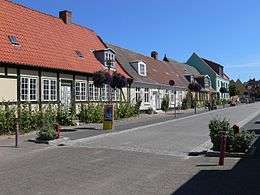 Old houses in Stubbekøbing, Falster | |
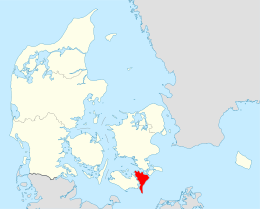 | |
| Geography | |
|---|---|
| Location | Baltic Sea |
| Coordinates | 54°48′N 11°58′E / 54.800°N 11.967°ECoordinates: 54°48′N 11°58′E / 54.800°N 11.967°E |
| Area | 486.2[1] km2 (187.7 sq mi) |
| Administration | |
| Region | Region Zealand |
| Municipality | Guldborgsund Municipality |
| Largest settlement | Nykøbing Falster (pop. 16,405) |
| Demographics | |
| Population | 43,398 (2010) |
| Pop. density | 89.25 /km2 (231.16 /sq mi) |
Falster is an island in south-eastern Denmark with an area of 486.2 km2 (187.7 sq mi)[1] and 43,398 inhabitants as of 1 January 2010.[2] Located in the Baltic sea, it is part of Region Sjælland (County of Zealand) and is administered by Guldborgsund Municipality. Falster includes Denmark's southernmost point, Gedser Odde, near Gedser.[3]
The largest town is Nykøbing Falster with over 40% of the island's inhabitants. Other towns include Stubbekøbing, Nørre Alslev and Gedser.
Falster has motor and railway links both to the larger island of Zealand to the north and to the island of Lolland to the south-west. These links also lead to the smaller islands of Masnedø and Farø. European route E47 links Copenhagen to Hamburg (Germany) via Falster.
History
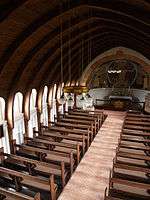
From medieval times until 1766, most of Falster belonged to the crown. King Valdemar's Census Book from c. 1231 lists all the parishes and most of the villages. Falster's two main towns, Nykøbing and Stubbekøbing, were both founded towards the end of the 12th century.[4]
In medieval times, the island was marked by wars with the Wends in 1158 and with Lübeck in 1253. The census of 1509 includes only 90 of the 110 villages mentioned earlier. By contrast, it mentions 29 new settlements mainly along the coast.
In the 16th century, Falster had a number of farms which were owned by the local nobility but, from 1560 to 1630, they were slowly returned to the crown which once again owned the entire island. Therefore, Falster could therefore be used as the dowry for Frederick III's wife, Sophie Amalie but as a result of the high taxes which resulted, many of the farms were deserted.
Falster was managed as a crown estate from 1718 until 1766 when it was sold by auction and divided up into ten large farms, five of which were given large new fields. But as the fields had to be prepared through the serfdom of local peasants, this led to many disputes.
The villages were replaced by the community from 1778 to 1814, and gradually moved to freehold tenants, a process which was only completed in about 1860.
Falster experienced significant economic expansion after 1880 when, with the establishment of cooperative dairies and slaughterhouses, farming was concentrated on livestock production and forage crops. There was also an increase in the cultivation of sugar beet which was processed in factories at Nykøbing and Stubbekøbing between 1890 and 1914. Many seasonal workers, especially women, from Sweden and Poland came to help with harvesting the sugar beet and some of them stayed.
With the new railway from Orehoved to Nykøbing in 1872 and railway ferries to Masnedø (1884) and Warnemünde (1903), Falster slowly became a traffic hub. Its position was reinforced by the construction of the Storstrøm Bridge (1937) and Farø Bridges (1985).
Since 1975, Falster has been marked by high unemployment as a result of harder times for both farming and industry.
Towns and villages
As of 2012, populations were as follows:[5]
|
|
|
Tourism
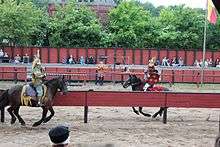
With its marinas, sandy beaches and cycle tracks, Falster attracts tourists who wish to have relaxing holidays in unspoilt surroundings. One of the most popular resorts is Marielyst on the east coast.[6]
Nykøbing offers a number of attractions including its old-town atmosphere with narrow streets. Of particular interest are the Middle Ages Centre, which is an open-air museum build as a part of a medieval town around year 1400 and the biggest attraction of the town.[7][8][9] Among other attractions in Nykøbing are the Abbey Church (Klosterkirke) which was built in the 15th century,[10] a City Museum and a zoo.
Scattered around the island are several minor museum such as Danish Tractor Museum and Crocodile Zoo in Eskilstrup, a motorbike and radio Museum in Stubbekøbing and a geological museum in Gedser, which holds the worlds largest polished garnet by the name of "Nordstjernen" (the Northern Star).[11][12][13]
Transport

Falster has a motorway and trunk roads linking its towns and villages.
Falster is connected to the larger island of Zealand to the north by the Farø Bridges (Farøbroerne) on European route E47 linking Copenhagen to Hamburg and the south. The Farø bridges join on the small island of Farø, and from there a further bridge gives access to the eastern neighbouring island of Møn. Falster is also connected to Zealand via the Storstrøm and Masnedsund bridges, via the island of Masnedø.
To the south-west, the E47 connects Falster to the island of Lolland via a tunnel under the Guldborgsund strait. There are two other bridges connecting to Lolland: the Guldborgsund Bridge at the northern end of the strait and the Frederick IX Bridge at Nykøbing Falster.
Nykøbing Falster's railway station is operated by Danish State Railways. There are regular passenger train services to Copenhagen via Ringsted. International trains operating between Copenhagen and Hamburg (via the train ferry between Rødby and Puttgarden) also call at the station. The company Lokaltog operates a rail service to Nakskov. The railway takes the Frederick IX bridge to Lolland and the Storstrøm and Masnedsund bridges to Zealand.
There are also frequent bus services linking Nykøbing with other towns and villages on the island as well as with destinations on Lolland, Møn and Zealand.[14]
Cultural references
- Marie Grubbe, whose tragic life has been the subject of several works of art including most notably Jens Peter Jacobsen's 1876 novel published in English as Marie Grubbe. A Lady of the Seventeenth Century in 1917, spent her last years in poverty on Falster.[15]
Notable residents
People who are born, or have lived on Falster include:
- Hans Egede (1686-1758), Lutheran missionary
- Peter Freuchen (1886-1957), Arctic explorer, author, and anthropologist
- Marie Grubbe (1643–1718), noble woman
- Bernhard Severin Ingemann (1789–1862), novelist and poet
- Peter Laurits Jensen (1886-1961) inventor of the first loudspeaker
- Frederik Magle (b. 1977), composer, organist and pianist
- Mads Rasmussen (b. 1981), rower
Gallery
 The Middle Ages Centre near Nykøbing
The Middle Ages Centre near Nykøbing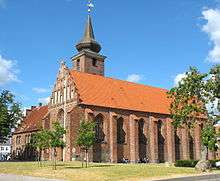 The Abbey Church in Nykøbing
The Abbey Church in Nykøbing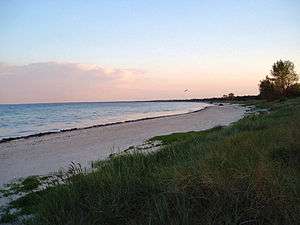 The beach at Marielyst
The beach at Marielyst- Corselitze Manor in central Falster
See also
| Wikimedia Commons has media related to Falster. |
References
- 1 2 "Islands By Land Area". Islands.unep.ch. Retrieved 2010-08-01.
- ↑ "Danmarks Statistik." Retrieved 28 June 2010.
- ↑ Falster. From Encyclopædia Britannica. Retrieved 21 January 2009.
- ↑ Falster. From Den store Danske. In Danish. Retrieved 21 January 2010.
- ↑ "BEF44: Population 1st January, by urban areas" database from Statistics Denmark
- ↑ Marielyst. In Danish. Retrieved 21 January 2010.
- ↑ Lonely Planet (2011). Denmark Travel Guide. Lonely Planet. pp. 239–240. ISBN 978-1-74321-287-5. Retrieved 2013-05-23.
- ↑ "Tv-klip: Anne-Vibeke Rejser - Lolland, Middelaldercentret i Nykøbing Falster". Rejseavisen. 2014-05-02. Retrieved 2014-05-10.
- ↑ Nykøbing Falster Havn. Sejlnet.dk. Hentet 19/11-2014
- ↑ Klosterkirkens historie. In Danish. Retrieved 21 January 2010.
- ↑ Det Sorte Geomuseum, visitdenmark.dk, hentet 29/6-2013
- ↑ Det Sorte Geomuseum. Den-lille-turisme.dk. Hentet 15/11-2013
- ↑ Det Sorte Museum Gedser Kulturhus, guldborgsund.dk, hentet 29/6-2013
- ↑ Movia bus routes. Retrieved 21 January 2010.
- ↑ "Hvem var Marie Grubbe???". Guldborgsund Municipality. Retrieved 2010-07-08.
External links
| Wikimedia Commons has media related to Falster. |